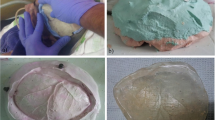Abstract
Objective
Patient-specific implants (PSI) for cranioplasty are expensive, and cost remains the limiting factor in low- to middle-income countries. The authors describe a novel, reproducible and cost-effective method of designing prefabricated titanium PSI cranioplasty.
Methods
Ten patients from June 2018 to December 2020 were included in this retrospective study. A three-dimensional stereolithography model was made on a custom-built 3D printer with variable layer heights to produce efficient and accurate details. A certain amount of defect in the temporal region was left uncovered to avoid complications related to temporalis muscle dissection. The stereolithography model with a cranial defect was reconstructed with modelling wax. The wax model was scanned with a blue light visible scanner. The digital data was transferred to the milling machine (Jayon Surgical®, Kerala, India), where a 1-mm-thick sheet of titanium was milled according to the specifications. RFCC scoring system was used for assessing cosmetic outcome.
Results
The mean duration of the surgery was 56.50 min, SD = 14.916 min (range 45–75 min). In 9/10 patients, the RFCC score was 4 points. No other complications were found at a minimum follow-up of 18 months in all patients. The cost per patient was approximately 30,000 INR or 400 US dollars. The average time required for us to get the PSI ready for surgery was about 15 days.
Conclusion
The authors demonstrate a novel, cost-effective and reproducible method of PSI using titanium for cranioplasty.



Similar content being viewed by others
References
Lu G, Zhu L, Wang X, Zhang H, Li Y (2020) Decompressive craniectomy for patients with traumatic brain injury: a pooled analysis of randomized controlled trials. World Neurosurg 133:e135–e148
Garg K, Singh PM, Singla R et al (2019) Role of decompressive craniectomy in traumatic brain injury - a meta-analysis of randomized controlled trials. Neurol India 67(5):1225–1232
Otani N, Takasato Y, Masaoka H et al (2011) Clinical characteristics and surgical outcomes of patients with aneurysmal subarachnoid hemorrhage and acute subdural hematoma undergoing decompressive craniectomy. World Neurosurg 75(1):73–77
Dillen WL, Pittman TA, Grupke SL (2018) Novel temporary treatment for a severe case of syndrome of trephined. World Neurosurg 120:200–204. https://doi.org/10.1016/j.wneu.2018.08.153
Gooch MR, Gin GE, Kenning TJ, German JW (2009) Complications of cranioplasty following decompressive craniectomy: analysis of 62 cases. Neurosurg Focus 26(6):E9
Roh H, Kim J, Kim JH et al (2019) Analysis of complications after cranioplasty with a customized three-dimensional titanium mesh plate. World Neurosurg 123:e39–e44
Nagarjuna M, Ganesh P, Srinivasaiah VS, Kumar K, Shetty S, Salins PC (2015) Fabrication of patient specific titanium implants for correction of cranial defects: a technique to improve anatomic contours and accuracy. J Craniofac Surg 26(8):2409–2411
Aydin S, Kucukyuruk B, Abuzayed B, Aydin S, Sanus GZ (2011) Cranioplasty: review of materials and techniques. J Neurosci Rural Pract 2(2):162–167. https://doi.org/10.4103/0976-3147.83584
Andrabi SM, Sarmast AH, Kirmani AR, Bhat AR. Cranioplasty: indications, procedures, and outcome – an institutional experience. Surg Neurol Int. 2017;8.
Lethaus B, Bloebaum M, Koper D, Poort-Ter Laak M, Kessler P (2014) Interval cranioplasty with patient-specific implants and autogenous bone grafts–success and cost analysis. J Cranio-Maxillo-fac Surg Off Publ Eur Assoc Cranio-Maxillo-fac Surg 42(8):1948–1951
Stephens FL, Mossop CM, Bell RS et al (2010) Cranioplasty complications following wartime decompressive craniectomy. Neurosurg Focus 28(5):E3
Williams LR, Fan KF, Bentley RP (2015) Custom-made titanium cranioplasty: early and late complications of 151 cranioplasties and review of the literature. Int J Oral Maxillofac Surg 44(5):599–608
Lethaus B, Bloebaum M, Koper D, Poort-Ter Laak M, Kessler P (2014) Interval cranioplasty with patient-specific implants and autogenous bone grafts–success and cost analysis. J Craniomaxillofac Surg 42(8):1948–1951
Honeybul S (2016) Management of the temporal muscle during cranioplasty: technical note. J Neurosurg Pediatr 17(6):701–704
Henker C, Hoppmann MC, Sherman MUS, Glass A, Piek J (2018) Validation of a novel clinical score: the Rostock functional and cosmetic cranioplasty score. J Neurotrauma 35(8):1030–1036
Sheng HS, Shen F, Zhang N, Lin FC, Li DD, Cai M, Jiang GQ, Lin J (2019) Titanium mesh cranioplasty in pediatric patients after decompressive craniectomy: appropriate timing for pre-schoolers and early school age children. J Craniomaxillofac Surg 47(7):1096–1103
Acknowledgements
The authors thank Dr R.N Sahu (Prof. and Head), Department of Neurosurgery AIIMS, Bhubaneswar, India, for their constant pursuance and guidance during this study, Mr Nachiketha, design head from Osteo3d®, Bangalore, India, for his considerable work in computer-aided designing.
Author information
Authors and Affiliations
Corresponding author
Ethics declarations
Ethics approval
All procedures performed in studies involving human participants were in accordance with the ethical standards of the institutional and national research committee and with the 1964 Helsinki Declaration and its later amendments or comparable ethical standards.
Consent to participate
Informed consent was obtained from all the individual participants included in the study.
Conflict of interest
The authors declare no competing interests.
Additional information
Publisher's Note
Springer Nature remains neutral with regard to jurisdictional claims in published maps and institutional affiliations.
Rights and permissions
About this article
Cite this article
Dash, C., Dasukil, S., Boyina, K.K. et al. A novel prefabricated patient-specific titanium cranioplasty: reconsideration from a traditional approach. Oral Maxillofac Surg 26, 223–228 (2022). https://doi.org/10.1007/s10006-021-00977-5
Received:
Accepted:
Published:
Issue Date:
DOI: https://doi.org/10.1007/s10006-021-00977-5




